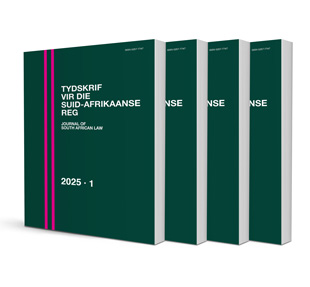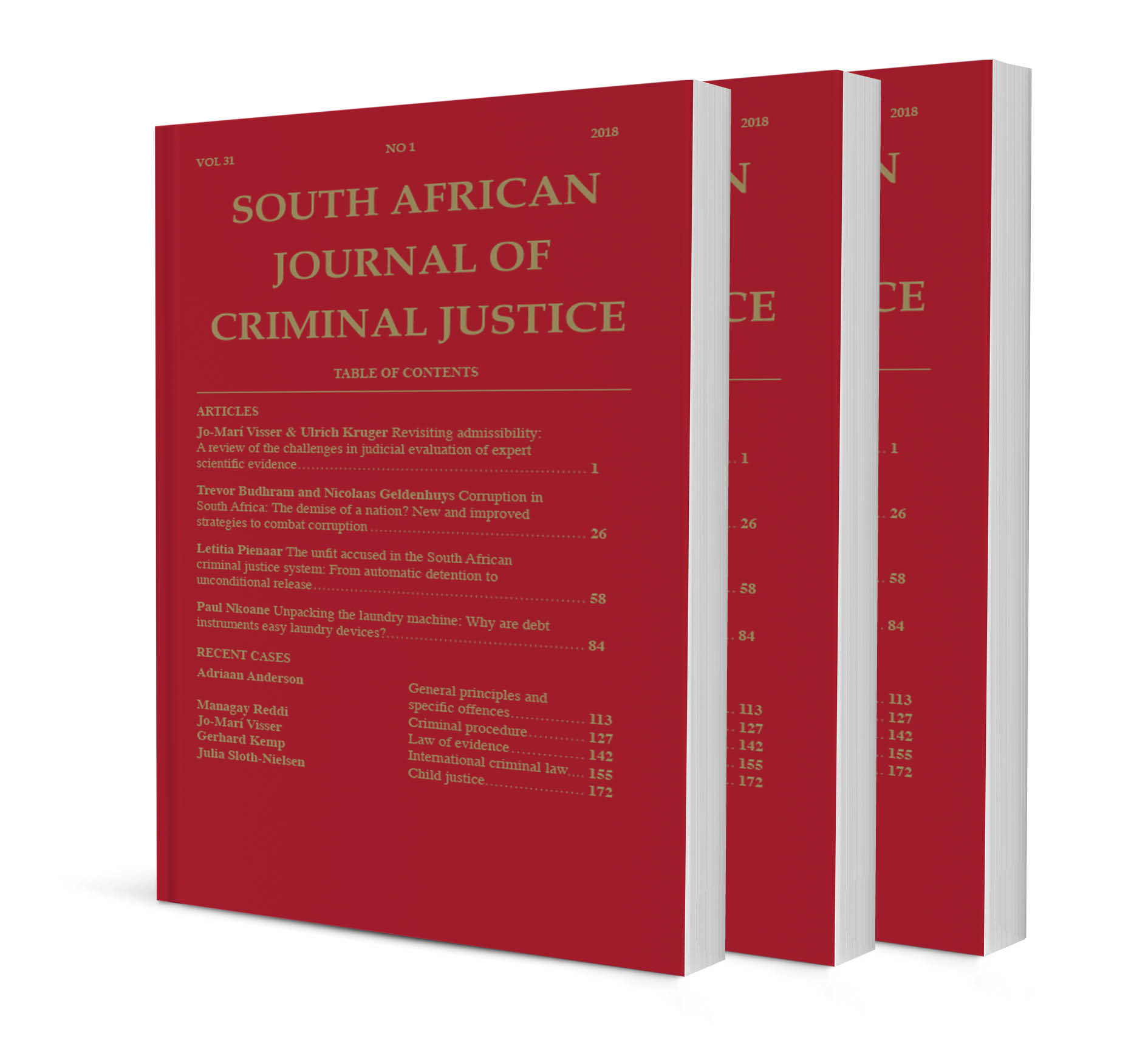Abstract
Twee interessante vrae het voor die hof gedien vir beslissing in die saak van Swanepoel v Depuy International Limited. Eerstens moes die Wes-Kaapse hooggeregshof, by monde van regter Wille, beslis of die verweerder, ’n vreemde peregrinus, by wyse van gedrag tot die jurisdiksie van die hof toegestem het. Tweedens, indien dit nie die geval was nie, moes regter Wille, in die alternatief, oorweeg of die gemenereg ontwikkel behoort te word deur te bevind dat die afwesigheid van beslaglegging van die verweerder se eiendom deur die eiser, ’n incola van die hof, ter bevestiging van jurisdiksie nie fataal was nie betreffende laasgenoemde se eisoorsaak, wat in die hof se gebied ontstaan het. Die verrigtinge was dus met ’n tussentydse dispuut gemoeid, wat voortgespruit het uit die verweerder se spesiale pleit dat die hof nie jurisdiksie gehad het om die hoofgeding tussen die partye te bereg nie.
Die feite in die hoofgeding is kortliks soos volg. Die eiseres, Chanine Swanepoel, ’n dierekunde-verpleegster en incola van die Wes-Kaapse hooggeregshof, het meer as tien jaar gelede ’n heupvervangingsoperasie by die Constantia Berg Medi-Clinic, in die hof se jurisdiksiegebied, ondergaan. Die operasie, wat die inplanting van ’n spesifieke heupvervangingsisteem, vervaardig deur die verweerder maatskappy, in die eiseres se regterheup behels het, is deur dr Hanna, ’n ervare ortopediese sjirurg, uitgevoer. Kort na die operasie is dr Hanna egter in kennis gestel dat die verweerder die heupvervangingsisteem weens latente defekte herroep het. Dit het dr Hanna genoop om met behulp van ander materiaal ’n tweede heupvervangingsoperasie op die eiseres uit te voer. Die nuwe prostese is egter tien dae na die operasie uit plek uit ontwrig, wat ’n derde operasie geverg het om dit reg te stel. ’n Dag na die laaste operasie het dieselfde weer gebeur, wat ’n vierde operasie genoodsaak het om die prostese te stabiliseer. Die voorafgaande mediese sage het die eiseres gemotiveer om ’n eis vir skadevergoeding van agt miljoen Rand op grond van nalatigheid teen die verweerder in te stel. Die verweerder het op die meriete gepleit, maar eerstens ’n spesiale pleit geopper waarin beweer is dat die hof nie jurisdiksie het om die saak te bereg nie. Die partye het ooreengekom dat die spesiale pleit geskei word van die hoofgeding en eerstens bereg word, aangesien ’n suksesvolle pleit ’n einde aan die geding sou bring. Die kern van die verweerder se spesiale pleit was dat die verweerder ’n peregrinus is met geen besigheidsplek in Suid-Afrika nie en dat by ontstentenis van ’n beslaglegging van die verweerder se eiendom in Suid-Afrika, die eiseres se skuldoorsaak gekelder is.
Die eiseres het geantwoord met ’n replikasie waarin sy in wese gepleit het dat die verweerder, deur die wyse waarop laasgenoemde die prostese hier bemark het, dit daarna herroep het en met die daaropvolgende gebeure gehandel het, onomwonde deur sy gedrag toegestem het tot die jurisdiksie van die Suid-Afrikaanse howe.
Regter Wille se beslissing kan onder twee hoofde saamgevat word, eerstens sy bevinding betreffende toestemming tot jurisdiksie en tweedens sy argument rakende die ontwikkeling van die gemenereg. Die regter beslis dat toestemming tot jurisdiksie deur ’n vreemde peregrinus as verweerder in ’n aksie vir skadevergoeding ingestel deur ’n incola as eiser ’n voldoende grond is vir die hof om jurisdiksie te vestig. Ter ondersteuning van dié bevinding het die hof na twee uitsprake van die hoogste hof van appèl verwys, naamlik Hay Management Consultants (Pty) Ltd v P3 Management Consultants (Pty) Ltd en Ingosstrakh v Global Aviation Investments (Pty) Ltd. Die volgende vraag was of die verweerder deur sy optrede toegestem het tot die jurisdiksie van die hof. Die regter het die feite oorweeg en bevind dat daar inderdaad sodanige toestemming deur die verweerder was.
In die alternatief het die hof bevind dat, selfs in die afwesigheid van toestemming deur die verweerder en beslaglegging op laasgenoemde se eiendom, daar ’n behoefte in dié geval was om die gemenereg te ontwikkel deur te bevind dat die hof steeds jurisdiksie kan vestig. Dit was egter onderworpe gestel aan die vereiste dat daar een of ander faktor aanwesig moes wees wat die saak met die hof verbind het. In casu was daar twee sodanige faktore aanwesig, naamlik die eiseres was ’n incola van die hof en die skuldoorsaak het in die hof se gebied ontstaan.
Die skrywer het die beslissing geëvalueer met verwysing na ander relevante regspraak, veral Vedanta Resources Holdings Limited v ZCCM Investment Holdings PLC, en tot die gevolgtrekking gekom dat beide aspekte van regter Wille se uitspraak in beginsel nie bevraagteken kan word nie. Die enigste punt van kritiek wat geopper kan word, is dat die regter se argument betreffende die ontwikkeling van die gemenereg ietwat oppervlakkig is. Daar is byvoorbeeld nie verwys na artikel 173 van die grondwet van 1996, wat die hoër howe magtig om onder andere die gemenereg in belang van geregtigheid te ontwikkel nie. ’n Verwysing na die artikel en die inhoud wat aan die belang van geregtigheid gegee moes word, sou meer substansie aan dié deel van die uitspraak gegee het.
Die huidige posisie volgens resente regspraak kan kortliks soos volg saamgevat word. Toestemming tot jurisdiksie deur ’n vreemde peregrinus verweerder word as ’n selfstandige grond vir jurisdiksie beskou en beslaglegging van laasgenoemde se eiendom word nie meer as ’n vereiste gestel nie, mits daar een of ander faktor aanwesig is wat die saak met die hof verbind. Dit sou die geval wees as die eiser ’n incola van die hof is of as die skuldoorsaak in die hof se gebied ontstaan het. Selfs waar beide partye vreemde peregrini is, sou toestemming tot jurisdiksie voldoende wees om die hof met jurisdiksie te beklee, mits daar ’n relevante verbindingsfaktor aanwesig is. Dit sou die geval wees indien die skuldoorsaak in die hof se gebied ontstaan het. Selfs as beide partye vreemde peregrini is, die skuldoorsaak nie in die hof se gebied ontstaan het nie, daar geen beslaglegging van die verweerder se eiendom was nie én laasgenoemde het nie tot jurisdiksie toegestem nie, sou die hof steeds jurisdiksie kan vestig indien daar ’n voldoende verbindingsfaktor aanwesig is. Dit sou byvoorbeeld die geval wees indien die setel van die hof as plek van arbitrasie ingevolge ’n ooreenkoms tussen die partye aangewys is.
Die bespreking werp ook ’n blik op die posisie in die Australiese reg in vergelyking met die Suid-Afrikaanse gemenereg. Die verskillende state en gebiede (“territories”) in Australië gee erkenning aan toestemming tot jurisdiksie deur ’n verweerder wat sy of haar persoon betref, maar dit speel ’n baie geringe rol in die praktyk, vergeleke met die posisie in Suid-Afrika. Enkele gesaghebbende handboeke oor siviele prosesreg noem toestemming tot jurisdiksie baie kortliks, terwyl ander eweneens hoog aangeskrewe soortgelyke bronne swyg oor die onderwerp. Die verskillende jurisdiksies in Australië maak almal voorsiening, met verlof van die hof, vir die betekening van ’n inisiërende proses in die buiteland maar in die konteks word geen melding van toestemming tot jurisdiksie deur die verweerder gemaak nie, alhoewel dit sekerlik moontlik moet wees. Eweneens noem die bronne nie die moontlikheid van ’n beslaglegging van die verweerder se eiendom in Australië om jurisdiksie te vestig of te bevestig nie. Na die mening van die skrywer, wat vir agt jaar ’n professoraat aan Curtin University in Perth beklee het, bestaan sodanige prosedure nie in die verskillende jurisdiksies in Australië nie. In teenstelling hiermee, het sekere Romeins-Hollandse prosesregtelike beginsels, onder andere toestemming tot jurisdiksie deur ’n verweerder, behoue gebly na die Engelse prosesregtelike hervormings aan die Kaap in die vroeë negentiende eeu. Die Australiese jurisdiksies het geen deel aan hierdie historiese erfenis nie en dit blyk dus dat hulle in dié opsig armer is.

